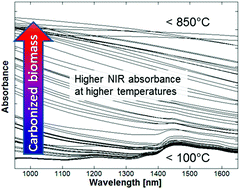NIR provides excellent predictions of properties of biocoal from torrefaction and pyrolysis of biomass
Abstract
When biomass is exposed to high temperatures in torrefaction, pyrolysis or gasification treatments, the enrichment of carbon in the remaining ‘green coal’ is correlated with the temperature. Various other properties, currently measured using wet chemical methods, which affect the materials’ quality as a fuel, also change. The presented study investigated the possibility of using NIR spectrometry to estimate diverse variables of biomass originating from two sources (above-ground parts of reed canary grass and Norway spruce wood) carbonised at temperatures ranging from 240 to 850 °C. The results show that the spectra can provide excellent predictions of its energy, carbon, oxygen, hydrogen, ash, volatile matter and fixed carbon contents. Hence NIR spectrometry combined with multivariate calibration modeling has potential utility as a standardized method for rapidly characterising thermo-treated biomass, thus reducing requirements for more costly, laborious wet chemical analyses and consumables.


 Please wait while we load your content...
Please wait while we load your content...